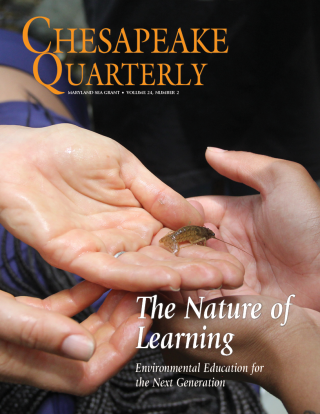Knauss legislative fellowships in Congress help build careers — and they're fun and educational. See our video and fact sheet for details.
The Maryland Sea Grant Bookstore will be closed for the winter holidays from Monday, December 15th to Friday, January 2nd and will not be taking orders during that time.
Research Publications: UM-SG-RS-2003-22
Title:
The responses of Patuxent River upper trophic levels to nutrient and trace element induced changes in the lower food web.
Year:
2003Authors:
Bundy, MH; Breitburg, DL; Sellner, KGSource:
Estuaries 26 ( 2 ) : 365 - 384DOI:
10.1007/BF02695974Abstract:
As a result of human activities, coastal waters can be exposed to multiple stressors that affect primary producers and their interactions with higher trophic levels. Mesocosm experiments were conducted during spring and summer 1996-1998 to investigate the responses of natural populations of primary producers to multiple stressors and the potential for these responses to be transmitted to higher trophic levels (i.e., copepods, bivalves, anemones, and fish). ne effects of two stressors, elevated nutrient and trace element loadings, were examined individually and in combination. Nutrient additions had a positive effect on biomass, productivity, and abundance of primary producers (Breitburg et al. 1999; Riedel et al. 2003). Growth or abundance of consumers increased with nutrient additions, but the magnitude of the response was reduced relative to that of their prey. Responses to trace element additions varied seasonally and among taxa. The responses of zooplankton and bivalves to stressor additions were affected by the biomass and changes in species composition of phytoplankton assemblages. The presence of fish predators did not alter zooplankton responses to stressor additions. These results suggest that the extent to which nutrient and trace element effects are transmitted from primary producers to higher trophic levels depends on the capacity of consumers to respond to stressor-induced changes in abundance and species composition of prey, on the absolute abundance of prey, and on the ability of predators to feed on alternative prey. The magnitude of the effects of stressors on estuarine food webs may depend on seasonal variability in species composition of phytoplankton assemblages, whether sensitive species dominate, and whether these species are important prey for secondary consumers. Because spatial and temporal patterns in nutrient and trace element loadings to the estuary can affect species composition of primary producers, it is critically important to examine the magnitude, timing, and spatial relationships of loadings of multiple stressors to coastal waters in order to understand the impacts of these stressors on higher trophic levels.
Related Research Project(s) Funded by Maryland Sea Grant:
Maryland Sea Grant Topic(s):
'Related Research Project(s)' link to details about research projects funded by Maryland Sea Grant that led to this publication. These details may include other impacts and accomplishments resulting from the research.
'Maryland Sea Grant Topic(s)' links to related pages on the Maryland Sea Grant website.





